Pheasant Ravioli with a Chestnut Sauce and Curly Kale Pesto
It’s amazing the lovely colours that we can still achieve even in the heart of winter. I always used to imagine and think that winter food was dull, heavy and mostly brown until fairly recently. Winter has become one of my favourite seasons to cook as I can experiment with meat cuts that require long and slow cooking times and also it’s the time of year when we have plenty of game and alternative meats available to us.
Pheasant is one of my seasonal favourites. I get my pheasants from a local butcher, I know they are fresh and local which is always a bonus.
Curly kale is in season at the moment and is part of the cabbage family. It is rich in iron with it’s bright green leaves, perfect to liven up my winter plates. I like most of the cabbage family but I have a golden rule it must be cooked well. I cannot stand cabbage cooked al dente, o.k then, but not completely dead either, for me curly kale falls into the well cooked category. One of my favourite ways to enjoy curly kale is to cook it in rapid boiling water until tender, then fold it through very buttery mashed potato,mmmm it’s super delicious!
Today I have spread my wings and made something different with the curly kale, this delicious curly kale and chestnut pesto is bang in season. I have used fresh chestnuts for the pesto, but if you cannot find fresh ones then the vacuum packed ones from the ambient section in the supermarket are just as tasty. The left over pesto makes a yummy pasta sauce. Bring some cream to the boil, stir in a generous amount of the curly kale pesto and toss it through cooked pasta for a quick supper.
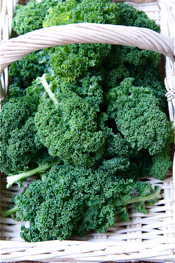
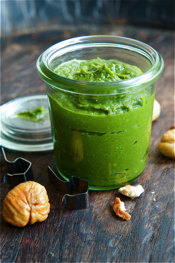
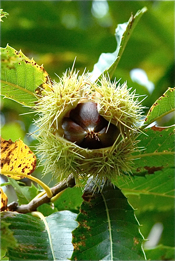
I used to be the ravioli queen in one of the restaurants where I worked. As I have small hands I was nominated to make the ravioli twice a day, every day. Well it was a task and a half as the master was very particular about his ravioli so I could not risk getting it wrong. So with years of practice and experience I shall attempt to pass the knowledge onto you.
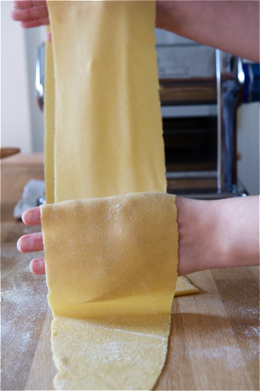
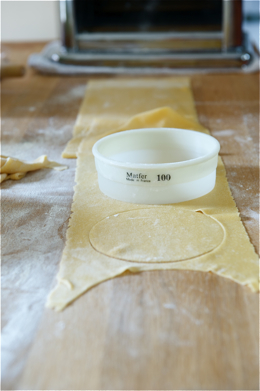
I use “00″ pasta flour available from the specialist food stores and delicatessens. It’s important to make sure you buy the correct flour as it should be super fine. I also use a pasta machine to make the pasta and they are not very expensive. I love making pasta as it’s very therapeutic and you feel a great sense of achievement once you have made these beautiful parcels of delicate pasta with an equally intricate filling.
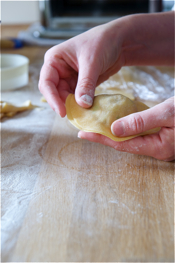
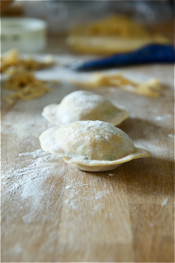
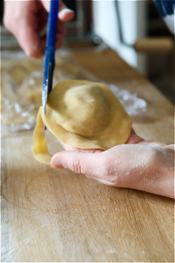
This dish is the perfect starter to show- off but it does require a bit of hard work but the return is brilliant!
Fresh Egg Pasta
- 275g 'oo' Pasta flour
- 2 whole medium free range eggs
- 3 medium free range egg yolks
- 1tbs olive oil
- Pinch of salt
Use a food processor to make the pasta dough.
Weigh the flour, salt and oil into the bowl and pulse a couple of times to rub the oil into the flour.
Add the egg yolks one at a time while the blade is running, followed by the whole eggs, blend for about 2 minutes until the pasta dough forms a ball.
Turn the dough out onto a lightly floured work surface and knead the dough ball for 4 minutes until it's smooth and silky but a tight dough ball.
Clingfilm the dough tightly and place in the fridge for 1 hour to rest and chill.
Pheasant Ravioli Stuffing
- 2 pheasant legs
- 1 bay leaf
- 1 clove of garlic
- Sprig of thyme
- Salt and freshly cracked black pepper
- 1L duck or goose fat
- 120g chicken breast meat
- 20g egg white
- 60ml double cream
- 1 tbs chopped mixed soft herbs such as chives, chervil, tarragon and parsley
First confit the pheasant legs in the fat:
Preheat the oven to 150°C. Season the pheasant legs with salt and pepper, leave to marinade for 1 hour.
Heat the duck or goose fat in a small oven proof tray or dish, add the crushed clove of garlic, thyme and bay leaf. Pat the pheasant legs dry with kitchen paper and add them to the warm duck fat, ensure that the legs are covered completely with the fat.
Over low heat bring the fat to a gentle simmer, cover the fat with a parchment paper and place a lid on the dish. Place in the preheated oven for 2 hours.
Test if the pheasant legs are cooked. If the bones wiggle and the meat flakes easily it's ready to be removed from the fat. Drain the legs and let them cool slightly before removing the skin and flaking meat, let it cool completely once flaked.
Secondly make a chicken mousse:
Place the chicken breast meat and the egg white in a food processor and puree until smooth.
Add seasoning and the cream, pulse until the cream is incorporated. Do not over work the chicken mousse as the cream will separate.
Thirdly make the ravioli filling:
Weigh 100g of the flaked cooked pheasant leg meat into a mixing bowl.
Add the chopped mixed herbs and 100g of the chicken mousse, use a spatula to fold all the ingredients together, work quickly but lightly. if you over work the mix it will separate.
Adjust the seasoning if needed.
Place the filling in the fridge to chill and firm up for about 1 hour before making the ravioli. Once the mix is chilled and firm, divide the mixture into four 5og balls, let them chill in the fridge.
Pheasant Ravioli
- Fresh egg pasta
- 1 egg, whisked
- flour for dusting
- 4 ravioli pheasant stuffing balls
Roll the pasta out to 1mm thick using a pasta machine, cut 10cm disks, you will need 8 disks.
Place a ravioli stuffing ball on 4 disks,brush them with the whisked egg and then place another piece of pasta disk on top of each. Dust your hands with flour and lift the ravioli in your hand gently pushing the air out and pinching them together. They will look like space ships.
Cut each one with a pair of scissors to remove the excess pasta.Please look at the photos above.
Next step will be to cook them, follow the assembly part of the recipe below.
Pheasant and Chicken Stock
- Carcase of the pheasant and the leg bones
- 500g chicken wings
- 1 stick of celery, chopped in four
- 1 large carrot, sliced
- 1 onion, cut in 1/8's
- 1 clove of garlic, crushed
- 1tsp sunflower oil
- One bay leaf
- Large sprig of thyme
- 150ml white wine
- 1/2 tsp coriander seeds
- 5 white pepper corns
- 1.2L water
Preheat the oven to 200°C.
Place the pheasant carcase and leg bones on a roasting tray and roast it for 30 - 35 minutes until dark and well roasted.
Prepare the vegetables, wash and cut it into even size pieces.
Heat a large saucepan with the oil and brown the vegetables until golden brown, add the coriander seeds, peppercorn, bay leaf and thyme.
Add the browned partridge bones, chicken wings (not roasted), deglaze with the wine and cook until the wine becomes sticky and coating the vegetables and bones.
Add the water, bring to the boil, reduce the heat to a gentle simmer. Skim the impurities with a ladle and simmer the stock for 30 minutes.
Pass the stock through a fine sieve or muslin cloth, discard the bones and vegetables and keep the stock refrigerated until needed.
Makes approximately 750ml stock.
Chestnut Foam
- 500ml pheasant and chicken stock
- 120ml double cream
- 20g butter
- 1 leek. sliced and washed
- 1 banana shallot. peeled and sliced
- Sprig of thyme
- 1 clove of garlic crushed
- 50ml white wine
- 150g chestnuts, vacuum pouch preferably available form the ambient shelf in supermarkets
- 1tsp lecithin powder
Heat a large saucepan with the butter and saute the leek, shallot and garlic until golden, add the thyme and chestnuts, deglaze the pan with the wine and cook until the wine becomes syrupy and sticky.
Add the stock and bring the sauce to the boil, reduce the heat and simmer the sauce for 25 minute. Add the cream, bring the sauce back to the boil and simmer for 5 minutes.
Blend the sauce until smooth and pass the sauce through a fine sieve, let the sauce cool.
TO HEAT AND SERVE THE SAUCE: When you are ready to serve pour 250ml of the cooled sauce back into a saucepan and add the lecithin powder, blend until the sauce foams heavily, gently heat the sauce over low heat until warm but not boiling, foam again until a heavy foam blanket sits on top of the sauce, leave it to settle for a couple of minutes and serve the foam, scooping it from the surface.
Curly Kale and Chestnut Pesto
- 2 cloves of garlic
- 80ml + 1tsp olive oil
- 200g curly kale, stalks removed
- 60g Baby Spinach also known as pousse
- Salt and freshly cracked black pepper
- 1tsp Dijon mustard
- Zest of one unwaxed lemon
- 15g grated Parmesan cheese
- 15g roasted chestnuts
- 15ml balsamic vinegar
Wrap 2 cloves of garlic tossed in 1 tsp of olive oil in foil and roast it at 200°C for 20 minutes. Remove the husks and keep the roasted garlic pulp.
Bring a large saucepan with salted water to the boil. Blanch the curly kale for 7 minutes in the boiling water, add the pousse for the last 30 seconds of the cooking time and refresh in ice water until completely cold, drain.
Squeeze the kale and pousse to remove the excess water.
Place the squeezed curly kale and pousse along with the roasted garlic pulp, 80ml of olive oil, freshly cracked black pepper, sea salt, Dijon mustard, the lemon zest, roasted chestnuts, Parmesan cheese, balsamic vinegar into a blender and puree until the desired consistency. Taste and adjust the seasoning if needed. I like my pesto smooth however it would be just as delicious if you made it slightly chunky.
Keep refrigerated until needed.
Assembly of the dish
- 4 Raviolis
- 100g blanched and buttered curly kale
- curly kale and chestnut pesto
- Chestnut Foam
- Fresh chestnuts out of the shell
- Olive Oil
Bring a large saucepan filled with water to the boil to cook the ravioli.
Cook the buttered curly kale and keep it warm.
Reheat and foam the sauce: When you are ready to serve pour 250ml of the cooled chestnut sauce back into a saucepan and add the lecithin powder, blend until the sauce foams heavily, gently heat the sauce over low heat until warm but not boiling, foam again until a heavy foam blanket sits on top of the sauce, leave it to settle for a couple of minutes and serve the foam scooping it from the surface.
Cook the ravioli in the rapid boiling water for 4 minutes, gently remove them from the water and drain them on kitchen paper.
Divide the buttered kale between 4 plates, place a ravioli on top of each. Place a quenelle of the pesto on top and spoon the chestnut foam around. Finish the dish with olive oil and freshly grated chestnuts, serve immediately.
Serves 4
Print Recipe Print Recipe with Photo Email this Recipe

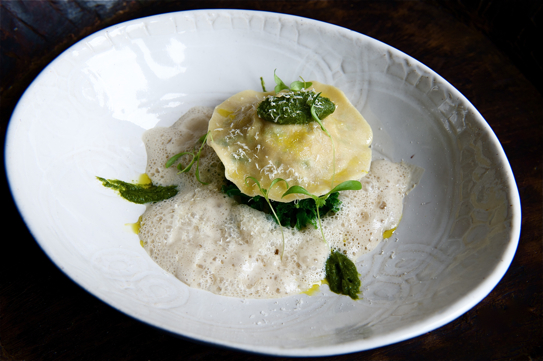

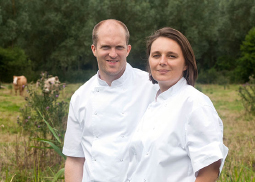
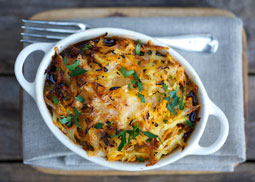
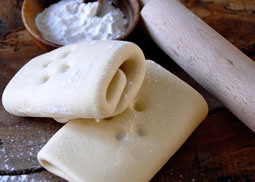
Hi Maddy, me again, Alan Murchison at L’ortolan (1 Michelin star) uses his Varoma steamer above the Thermomix to steam his raviolis for service. They put each one on a piece of greaseproof paper and cover with the same, then steam until the fresh pasta is tender and the filling is cooked. He said this has reduced his waste from about 40% to zero.
Hi Maddy, the kale pesto is a super idea – I have some kale in the garden! Have you tried cabbage pesto? mustard greens pesto? (just ideas, but pretty sure they would work too). A favourite of mine is parsley and walnut pesto, perfectly smooth and very easy with my Thermomix. Also salad pesto, for that bag of salad you buy and forget to serve at dinner – a great way to use it up the next morning when you find it in the fridge.
lovely. i feel that kale is way too underused in our cooking (american) and it’s still one of the cheapest and heartiest greens you can buy. We eat it almost once or twice a week. Holds up to alot of cooking and it’s so good for you.
Love the use of pheasant in your ravioli (raviolo? can’t see the size)… i wish we could get pheasant more easily! Beautiful, seasonal dish… love your blog!
I am saving my Flybuy points to get a pasta maker. This will be true therapy to be able to savour home made pasta. I gave up buying fresh pasta a while ago from the supermarket after I found every one tasted the same. I’d rather use dried pasta and make a super delicious sauce than eat pappy ravioli or tortolleni.
That’s a lot of work, but it seems like pleasant pheasant kitchen work with a satisfying outcome for the eyes and the stomach.
I have always put Kale and Chestnuts together (and lots of butter), its a great flavour and nothing new, what is new is making a pesto with the two, I will try this, bloody great idea, as was this whole site of yours Maddie.
What a gorgeous looking dish! Such a beautiful presentation!
This dish sounds absolutely wonderful! I love pheasant (and kale too), and the chestnut sauce must have been incredible with the ravioli.
I love pheasant, too. It’s like turkey, but with a whole lot more flavor and interest. Thanks for the idea about making pesto out of kale. Never have tried that before. But I can imagine how wonderful and different that would be.
This looks great. The colour of the kale-pesto; brilliant!
But what is pousse?